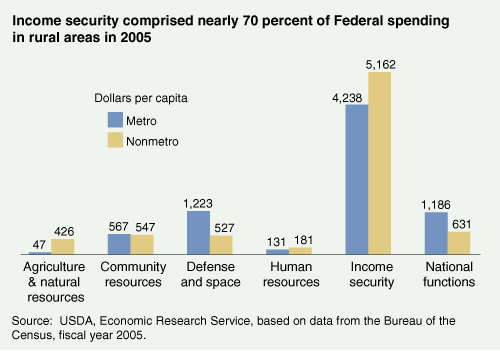Federal Funding in Rural America Goes Far Beyond Agriculture
- by Richard Reeder and Faqir Bagi
- 3/1/2009
For the first time in the nearly 40 years that ERS has been analyzing the geographic distribution of Federal spending, rural areas received more in total per capita Federal funding ($7,473) in fiscal year (FY) 2005 than urban areas ($7,391). This reversal is likely due to changes in the housing market, as many home buyers—particularly in urban areas—opted to use more flexible and risky private-sector mortgages instead of federally insured mortgages in 2005. Between 2004 and 2005, community resource programs, including housing, infrastructure, and business assistance, declined 34 percent in urban areas but only 3 percent in rural areas. Recently, many urban home buyers began using federally backed mortgages again, suggesting that the rural funding advantage may be short lived.
Federal spending in rural communities can have a significant impact on rural economies. However, the amount of spending may be less important as an indicator of its effect than its intended use. For example, while important to the recipients, spending on social services may have less impact on rural economies than an equal amount of spending on basic infrastructure because people are mobile while infrastructure is geographically fixed.
Rural areas received more per capita for human resources, including education, nutrition, training, and social and health services, than urban areas did. These patterns reflect greater percentage shares of elderly, poor, and less educated populations in rural areas.
Rural areas also received more per capita in Federal agricultural and natural resource funds than urban areas did in FY 2005 (the most recent year for which accurate county-level data are available). Activities covered by this funding (agricultural payments, agricultural research and services, forest and land management, and water and recreational resources) tend to be land intensive, and rural communities encompass about 75 percent of the Nation’s land area. But funds from agricultural and natural resource programs were dwarfed by those from income security programs in FY 2005. Income security, including Social Security, Medicare, and other Federal income support, comprised nearly 70 percent of Federal spending in rural areas, far surpassing its 57-percent share in urban areas.
This article is drawn from:
- Kusmin, L. (2008). Rural America At A Glance, 2008 Edition. U.S. Department of Agriculture, Economic Research Service. EIB-40.
We’d welcome your feedback!
Would you be willing to answer a few quick questions about your experience?


